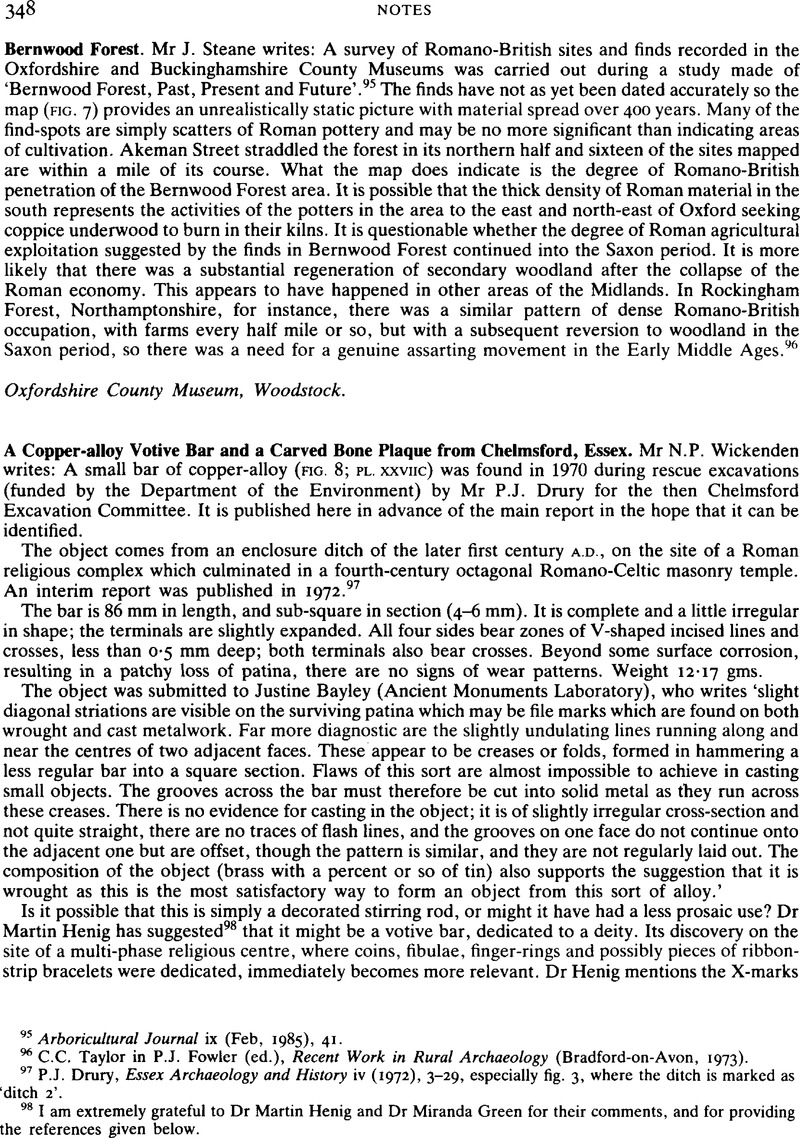No CrossRef data available.
Article contents
A Copper-alloy Votive Bar and a Carved Bone Plaque from Chelmsford, Essex.
Published online by Cambridge University Press: 09 November 2011
Abstract

- Type
- Notes
- Information
- Copyright
- Copyright © N. P. Wickenden 1986. Exclusive Licence to Publish: The Society for the Promotion of Roman Studies
References
97 Drury, P.J., Essex Archaeology and History iv (1972), 3–29,Google Scholar especially fig. 3, where the ditch is marked as ‘ditch 2’.
98 I am extremely grateful to Dr Martin Henig and Dr Miranda Green for their comments, and for providing the references given below.
99 Green, M.J., Arch. Journ. cxxxii (1975), 54–70,Google Scholar esp. p. 59, and figs. 2–17, 3–300, 5–65a-b; Green, M.J., Britannia xii (1981), 253–269,CrossRefGoogle Scholarpassim; Clifford, E.M., Trans. Bristol Glos. Arch. Soc. lx (1938), 297–307,Google Scholar esp. p. 305, and fig. 26. no. 6, for an altar with St. Andrew crosses from Lypiatt Park, Stroud.
100 Green, M.J., East Anglian Arch, xxv (1985), 44–6Google Scholar ; Green op. cit. (note 99), 59.
101 Wright, R.P., Ant. Journ. 1 (1970), 257–9,Google Scholar esp. fig. 7C The final report on Henley Wood, including the rings by M. Henig, is being prepared by Western Archaeological Trust. The C in the inscription is retrograde, and Wright suggests that the N is a sideways S.
102 M.J. Green, A Romano-British ceremonial bronze object found near Peterborough, Peterborough City Museum Monograph 1 (1975).
103 Green, M.J., Coll. Latomus clxxxiii (1984), 66–71Google Scholar and pl. lxiv, figs. 27, 28. For a discussion of the cross-sign as a votive symbol, see Rottländer, R.C.A., Kölner Jahrbuch für Vor-und Frühgeschichte xii (1971), 94–109.Google Scholar
104 op. cit. (note 99), fig 3. Pit 29.
105 Dr Catherine Johns and Dr Stephen Greep concur with this view, although Dr C. Rüger of the Rheinisches Landesmuseum thought, at the time of excavation, that it might be Frankish, and 7th- to 8th-century in date.
106 Toynbee, J.M.C., Art in Britain under the Romans (1964), 362,Google Scholar pl. lxxxii b. The bust is female (?) with a similar neckline.
107 Note the busts of Christ and the Apostles on the ivory Brescia Casket, dated to the second half of the fourth century, though much finer in quality (Volbach, W.F., Early Christian Art (1961), 328,Google Scholar pls. 85–87). I am grateful to Dr Henig for his comments on this.




